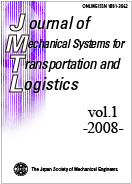Volume 1, Issue 3
Displaying 1-9 of 9 articles from this issue
- |<
- <
- 1
- >
- >|
Papers
-
2008 Volume 1 Issue 3 Pages 240-251
Published: 2008
Released on J-STAGE: July 31, 2008
Download PDF (851K) -
2008 Volume 1 Issue 3 Pages 252-263
Published: 2008
Released on J-STAGE: July 31, 2008
Download PDF (2313K) -
2008 Volume 1 Issue 3 Pages 264-271
Published: 2008
Released on J-STAGE: July 31, 2008
Download PDF (972K) -
2008 Volume 1 Issue 3 Pages 272-280
Published: 2008
Released on J-STAGE: July 31, 2008
Download PDF (506K) -
2008 Volume 1 Issue 3 Pages 281-292
Published: 2008
Released on J-STAGE: August 26, 2008
Download PDF (520K) -
2008 Volume 1 Issue 3 Pages 293-304
Published: 2008
Released on J-STAGE: October 07, 2008
Download PDF (358K) -
2008 Volume 1 Issue 3 Pages 305-318
Published: 2008
Released on J-STAGE: October 07, 2008
Download PDF (361K) -
2008 Volume 1 Issue 3 Pages 319-330
Published: 2008
Released on J-STAGE: October 23, 2008
Download PDF (733K) -
2008 Volume 1 Issue 3 Pages 331-342
Published: 2008
Released on J-STAGE: November 10, 2008
Download PDF (401K)
- |<
- <
- 1
- >
- >|
